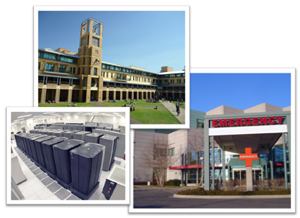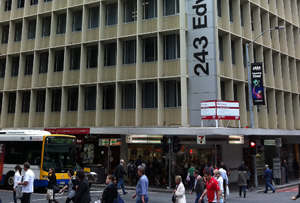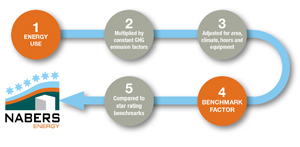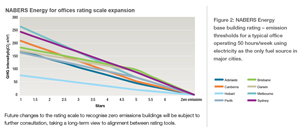Currently, NABERS provides separate ratings for:

Office building: This covers the environmental impacts of the activities and services traditionally supplied by, or within the control of, the landlords/operators of office buildings.
Office tenancy: This covers the environmental impacts of the activities that are under the control of office occupants.
Hotels: available for AAA-rated business hotels
Shopping centres: for centres over 15,000 sqm GLAR
Homes: This is designed for occupants of homes, covering all situations where the home carries all of its own services and land as a single identifiable package.
Ratings are also in development for hospitals, schools and data centres.
 NABERS measures the actual operational performance data of a building. In general NABERS is used for established buildings.
NABERS measures the actual operational performance data of a building. In general NABERS is used for established buildings.
Green Star Offices, developed by the Green Building Council of Australia, is designed to assess the environmental potential of office buildings. Green star ratings establish how the premises will perform under ideal circumstances based on design information and management processes.
The actual operational performance data established by NABERS ratings will complement Green Star ratings, establishing a valuable feedback loop to building designers, developers, tenants and owners.
Characteristics of high star and low star NABERS buildings
 This section looks pretty obvious right? High star NABERS buildings use less energy than low star NABERS buildings. This is true but what’s important to note is high energy use isn’t the only thing hurting the rating of low star building.
This section looks pretty obvious right? High star NABERS buildings use less energy than low star NABERS buildings. This is true but what’s important to note is high energy use isn’t the only thing hurting the rating of low star building.
Good ratings start with the basics, actual energy usage, current leases, current net lettable area plans, accurate building management systems and continued energy management plans.
One major factor I’d like to touch on today which can make or break a NABERS rating before it even starts is Metering.
Metering
You can have it all an energy efficient HVAC system, upgraded lighting and a state of the art BMS system but if your metering doesn’t provide the data that NABERS requires, your effort won’t be reflected in the rating.
If a buildings metering is inadequate its rating will encompass energy that should really be excluded, thus producing a worse NABERS rating.
For example, most office buildings have some mixed usage within the building. You may have a ground floor of retail tenants, coffee shop, 7-Eleven’s, and then above that 10 floors of office space.
The retail tenants will operate around 7 days a week, some all night. The office space will typically run 5 days a week 8 to 6pm. Think about the energy usage related to this. Now in general the base building HVAC and lighting will encompass the entire building retail and office. As far as NABERS is concerned, the area and energy usage of retail space on the ground floor should be excluded. However, if there is no meter recording the usage of the retail base building it cannot be excluded. The result is more energy over less acceptable net lettable area, thus giving a worse NABERS rating. If the space were correctly metered, the results would reflect a more accurate NABERS rating.
Car parks
What about car parks? If your tenants aren’t using the entire carpark exclusively and space is made available for the public, retail tenants, etc., that portion of energy usage can be excluded, but only if the car park is separately metered from the base building services.
We were delivering a NABERS rating for a client in Brisbane. The building had two car parks underground, one for the public to access retail spaces and one for the office tenants. There was no metering to exclude the retail car park therefore it was included in the NABERS rating.
Computer server rooms
Energy consumption of a computer server room may be partially or wholly excluded from tenancy or whole building rating on the grounds of external usage of the equipment. Server rooms use a high amount of energy. Ror example, if you have an IT company in your Melbourne office building and 50% of their server is functioning for the companies head office is Sydney. If the server room is sub-metered this 50% can be excluded from the energy usage of the space. Otherwise this energy must be included. This situation applies for a NABERS whole building or tenancy rating only.
 NABERS provides property owners, occupants, investors and other stakeholders with a reliable method of assessing the environmental impacts of buildings in use.
NABERS provides property owners, occupants, investors and other stakeholders with a reliable method of assessing the environmental impacts of buildings in use.
NABERS can be used to define and set operational performance targets and measure and rate actual performance. Accredited ratings can also be used to disclose and report on performance to interested parties, establish commercial relationships for the monitoring and maintenance of performance targets, enlist professional services to improve a rating, and make decisions about priority actions or investment options.
 The NABERS tool was originally developed by the Federal governments Dept. of Environment and Heritage. The NSW office of environment and heritage was selected as the successful tenderer to proceed with the commercialisation of NABERS, with the contract for NABERS commercialisation signed in March 2005.
The NABERS tool was originally developed by the Federal governments Dept. of Environment and Heritage. The NSW office of environment and heritage was selected as the successful tenderer to proceed with the commercialisation of NABERS, with the contract for NABERS commercialisation signed in March 2005.
OEH manages the operation and development of accredited NABERS rating systems throughout Australia. This is overseen by the NABERS National Steering Committee, which is comprised of representatives of the Australian and State and Territory Governments, and the Australian Sustainable Built Environment Council as an observer. NABERS is available throughout Australia, with accredited assessors available to perform accredited ratings in every state and territory.
Ausnviro provide NABERS ratings for commercial buildings.
NABERS ratings come in three different forms for Energy, Water, Waste & Indoor Environment.
 NABERS base building rating
NABERS base building rating
A NABERS base building rating covers the central services and common areas. This includes HVAC, common lighting, car parks, foyers etc.
NABERS tenancy rating
A NABERS tenancy rating covers the tenanted space. This includes tenant lighting, tenant supplementary a/c, and tenant power.
NABERS whole building
A NABERS whole building rating is a combination of the base building and tenancy. So it covers the entire building. A catch 22 for a building owner because it includes energy usage in their control (base building) and usage out of their control (tenanted space). This is unless of course the building owner and their business operations occupy the entire building..
Most are familiar with the commercial building disclosure laws. The type of NABERS rating used for this policy is a NABERS energy base building rating. There are some situations where a whole building rating is acceptable such as lack of metering but in general a base building rating must be sought.
When somebody mentions an office building with a NABERS energy rating they are generally referring to a NABERS base building rating. Any retrofitting for commercial and environmental sustainability of an office building will generally be reflected best in a NABERS base building rating. This as mentioned before includes the central services and common areas.
Call us now to request a quote: 1300 799 558
How is a NABERS Energy for offices rating calculated?
 1. The office building’s total Energy Use for a 12 month period is collected from billing data and meter readings.
1. The office building’s total Energy Use for a 12 month period is collected from billing data and meter readings.
2. The Energy Use is multiplied by the constant NABERS Greenhouse Gas (GHG) factor. The NABERS GHG factor stays constant from year to year so that ratings can be compared over time.
3. The Energy Use is also adjusted to account for area, climate, hours of occupancy and equipment density. This enables buildings with very different attributes to be compared against the same performance targets.
4. The corrected figure, called the Benchmark Factor, puts the building on a level playing field with other buildings in the same geographic location. The Benchmark Factor is not a kgCO2/m2 figure, but rather a value that enables a building to be located on the benchmark rating scale.
NABERS Energy for offices also calculates the Greenhouse Gas Emission Intensity of the building in kgCO2/m2 using current National Greenhouse Accounting factors for greenhouse reporting purposes. This information is provided in the NABERS Energy rating report that accompanies the rating.
5. The Benchmark Factor is compared against the star rating benchmarks, or performance targets, for the property market in the building’s own state, to determine the star rating.
6. A NABERS Energy Star rating is then awarded based on the performance level the building has achieved.
 The Benchmarks are the target performance levels that are represented by each of the star ratings. The Benchmarks were developed based on analysis of the performance levels of real buildings in each market. To compare a building against the benchmarks, its performance is ‘normalised’, or adjusted to account for the differences between its attributes and the attributes of a typical building.
The Benchmarks are the target performance levels that are represented by each of the star ratings. The Benchmarks were developed based on analysis of the performance levels of real buildings in each market. To compare a building against the benchmarks, its performance is ‘normalised’, or adjusted to account for the differences between its attributes and the attributes of a typical building.
For all NABERS ratings, the rating scale has been set so that 2.5 stars is representative of an Average performance. 5 stars has been set to represent Excellent performance, and the new 6 star level will be Market Leading. When the five star Benchmark scale is plotted on a graph, the Benchmarks form a linear scale for each location, with an equal reduction in GHG intensity between each star level.
How is a NABERS Energy rating for a hotel or shopping centre calculated?
 1. The hotel or shopping centre’s total Energy Use for a 12 month period is collected from billing data and meter readings.
1. The hotel or shopping centre’s total Energy Use for a 12 month period is collected from billing data and meter readings.
2. The Energy Use is multiplied by the current National Greenhouse Accounting factors, to calculate the Total Emissions in kgCO2-e.
3. The Total Emissions are compared to the predicted average emissions for a building with the same attributes, such as size, climate, functions and operation.
4. NABERS calculates the Percentage difference between the emissions of the rated building and the predicted average emissions for a building with the same attributes.
5. The Percentage is compared to the star rating benchmarks that form the rating scale.
6. A NABERS Energy Star rating is awarded based on the performance level the building has achieved.
 Quite different to the benchmarks for office ratings the hotel and shopping centre benchmarks are percentages based on how far the building’s actual performance differs from its predicted average. Real building performance was analysed in each major market to develop the benchmark.
Quite different to the benchmarks for office ratings the hotel and shopping centre benchmarks are percentages based on how far the building’s actual performance differs from its predicted average. Real building performance was analysed in each major market to develop the benchmark.
The rating scale has been set so that 2.5 stars represents Average performance. 5 stars was set to represent Excellent performance, and the new 6 star level will be Market Leading. When the five star Benchmark scale is plotted on a graph, the Benchmarks form a linear scale, with an equal percentage difference in GHG intensity between each star level.
NLA (Net Lettable Area) – Important factors when preparing for a NABERS assessment
 Your Assessor will need documentation on the net lettable area (NLA)
Your Assessor will need documentation on the net lettable area (NLA)
For a tenancy rating – the tenancy space being rated
For a base building or whole building rating – all the tenancies in the building.
Your evidence of the NLA may include layout plans of the premises, or lease documents.
The documentation must specify that the NLA is measured based on the Property Council of Australia (PCA) publication “Method of Measurement for Lettable Area” March 1997 or previous versions such as the BOMA 1989 standard or BOMA 1985 Method of Measurement.
It is important that the property area is current and valid for configuration of the premises during the rating period. If the plans are outdated or not available, we advise to have the floor plans revised or prepared by a registered surveyor before commencing the rating process. Your Assessor will visit the site to check that the information sources match the current configuration of the tenancy.
Note that NABERS for offices only rates the office spaces. Where a tenancy or building includes areas that are not actually office areas and not used exclusively by office occupants, such as a café open to the public, an Assessor may exclude that area from the rating. Your Assessor will know the rule that applies when excluding an area from the rating.
If some areas were vacant during the rating period, you will have to provide details of vacant areas (NLA) and the exact dates that the space was vacated and/ or re-occupied. An example is the lease documents that show these dates.
Common issues when obtaining net lettable area.
The measurement standard. The NABERS rules are explicit in regards to the standard in which each tenancy must be measured. We see this issue generally when a building is going through the NABERS assessment process for the first time. Tenant leases generally include a survey plan of their particular space. However not just any old survey plan will do. Each survey plan must be measured to the PCA 1997 standard or the equivalent.
If the owner does have these particular survey documents then there are only two options. Have a licensed surveyor carry out the measurements or have the NABERS assessor measure the tenancies to the standard on site. We will generally measure tenancies ourselves within reason. For example if only 10% – 30% of the leases don’t have survey plans and the layout of the tenancies is straight forward. We are happy to facilitate this. Having a NABERS assessor take the measurement s on site is much more cost effective than a surveyor.
Energy consumption – Important factors when preparing for a NABERS assessment.
 Preparation for a NABERS assessment is pivotal to gain an accurate NABERS rating.
Preparation for a NABERS assessment is pivotal to gain an accurate NABERS rating.
When preparing for a NABERS Energy for offices rating the following documentation will be required:
Energy consumption data
Your Assessor will need copies of the utility bills for all sources of energy consumed, such as electricity, gas, LPG, coal, oil, co-gen, tri-gen etc, in the last 12 months, the latest bill to be no more than four months old.
The energy consumption data included in a rating is different for each rating type:
for tenancy rating – energy consumed by building occupants, such as tenant’s light and equipment and tenant-controlled supplementary air conditioning, etc.
for base building rating – energy consumed by central services, for example common area lighting, lifts, air conditioning, etc.
for whole building rating – combination of the above.
Your Assessor is primarily concerned with the consumption data, i.e. the amount of electricity in kWh or gas in MJ, rather than the energy costs, so please ensure that you provide full copies of the bills and not just the first page to your Assessor.
Common issues when obtaining energy consumption data.
Estimated bills. These days, most utility companies read electricity meters remotely. However, depending on the age of your building this may not be the case, particularly in regards to gas metering. If you have a meter that needs to be read on site and for whatever reason the meter reader cannot gain access to the meters, the utility company will provide an estimated reading. NABERS treats this estimated reading as an error. Why is this bad? Depending on the amount of estimated readings, the entire building may be deemed as unrateable. NABERS require actual meter readings.
For example, I was carrying out a rating in Melbourne and when I audited the gas bills I discovered that only one bill from the last year was an actual meter reading. In order to continue the rating we had to go back four years to find the last actual meter reading. Using that reading against the actual NABERS site visit reading, we were able to ascertain the total gas use. However, the rating must only include a maximum of 365 days of usage. In this case, the entire four years of gas was applied to the one year. This is because there was no evidence of an actual meter reading since 2007. This of course resulted in a worsened rating.
Hours of occupancy – Important factors when preparing for a NABERS assessment.
 For base building ratings, the hours of occupancy are the agreed hours per week for which services are provided by the landlord to the tenants. This may include both core hours of service, i.e. regular hours requested by the tenant and defined in leasing documentation and after-hours air-conditioning that is requested by the tenant where records exist.
For base building ratings, the hours of occupancy are the agreed hours per week for which services are provided by the landlord to the tenants. This may include both core hours of service, i.e. regular hours requested by the tenant and defined in leasing documentation and after-hours air-conditioning that is requested by the tenant where records exist.
For tenancy and whole building ratings the hours of occupancy equals the number of hours per week for which the premises has 20% or more of normal peak occupancy. The Assessor who will survey your staff managers with a standard survey form determines this. Surveyed managers should have a good idea of the arrival and leaving patterns for people in their area. You are encouraged to prepare a list of managers’ names and contact details to facilitate the survey.
To help your Assessor understand the occupancy patterns, you are encouraged to provide floor plans showing the office layouts marked up with the various business departments or team locations if such groups have different occupancy hours.
Common issues in relation to hours of occupancy.
After hours air conditioning requests are important. This data will benefit the rating because it gives a more accurate gauge of the hours of occupancy. By obtaining this information the after hours air conditioning can be added to the core hours, resulting in the total building energy usage being spread over a longer time frame and thus giving a more accurate NABERS rating.
It still surprises me that the majority of data we are supplied for BMS systems cannot be used. The NABERS protocol is very strict in regard to the Data that can be used for after hours air conditioning.
Logs of AHAC requests by tenants, showing the time and date of each request and the space to which it applied or the source of the request, are acceptable data. There are no in-betweens.
Air conditioning operation records that do not show the time, date and source of requests are not acceptable, even if supported by evidence of after hours occupation of the space.
Records that only show the total ‘hours run’ or ’after-hours run’ for the air conditioning plant are not acceptable.
The determining factor is the tenant’s request to the building owner for service outside core hours, not the presence of occupants in the space or the operation of the plant.
What if you don’t comply?
 Building owners/lessors who fail to meet disclosure obligations, could face penalties of up to $110,000, as well as a maximum of $11,000 for each day beyond the first day that the breach continued.
Building owners/lessors who fail to meet disclosure obligations, could face penalties of up to $110,000, as well as a maximum of $11,000 for each day beyond the first day that the breach continued.
In addition, DCCEE can issue infringement notice penalties of up to one tenth of the maximum penalty that a court can impose. This means that a penalty can be imposed for each day that an office is offered for sale, lease or sublease without having registered the required information and including a NABERS Energy star rating in any advertisement.
The BEED Act also provides for the creation of an Energy Efficiency Non-disclosure Register to name those who repeatedly contravene the provisions of the Act. This would include people who are responsible for two or more instances of non-disclosure within 12 months. DCCEE monitors both advertisements and transactions for instances of non-disclosure.
Ausnviro provide BEEC certification services for commercial buildings.
What is Commercial Building Disclosure?
 Commercial Building Disclosure (CBD) is a national program designed to improve the energy efficiency of Australia’s large office buildings that is being managed by the Australian Government Department of Climate Change and Energy Efficiency.
Commercial Building Disclosure (CBD) is a national program designed to improve the energy efficiency of Australia’s large office buildings that is being managed by the Australian Government Department of Climate Change and Energy Efficiency.
The Australian, state and territory governments developed the CBD program as part of the National Strategy on Energy Efficiency. As part of the Strategy, governments will consider expanding the program to cover other building types (such as hotels, shopping centres and hospitals) from 2012.
Under the CBD program, most sellers or lessors of office space of 1,000 square metres or more are required to disclose an up-to-date Building Energy Efficiency Certificate (BEEC) if they wish to sell, lease or sublease that office space.
From 1 November 2011 a full Building Energy Efficiency Certificate (BEEC) will need to be disclosed. BEECs are valid for up to 12 months, must be publicly accessible on the online Building Energy Efficiency Register, and include:
a NABERS Energy star rating for the building
an assessment of tenancy lighting in the area of the building that is being sold or leased and
general energy efficiency guidance.
The NABERS Energy star rating must also be included in any advertisement for the sale, lease or sublease of the office space.